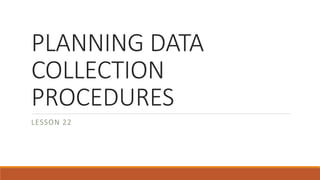Lesson 22 planning data collection procedures
•Télécharger en tant que PPTX, PDF•
5 j'aime•8,861 vues
PRACTICAL RESEARCH 2 POWERPOINT
Signaler
Partager
Signaler
Partager

Recommandé
Recommandé
Contenu connexe
Tendances
Tendances (20)
Lesson 12 citing related literature using standard styles

Lesson 12 citing related literature using standard styles
Lesson 4 Characteristics, Strengths, and Weaknesses of Qualitative Research.pptx

Lesson 4 Characteristics, Strengths, and Weaknesses of Qualitative Research.pptx
Practical research 2 charateristics strengths_weaknesses_kinds_tvv

Practical research 2 charateristics strengths_weaknesses_kinds_tvv
Similaire à Lesson 22 planning data collection procedures
Similaire à Lesson 22 planning data collection procedures (20)
Chapter 9 Data Collection Observation Interviews and Tests

Chapter 9 Data Collection Observation Interviews and Tests
chapter4-understandingdataandwaystosystematicallycollectdata-170809052400.pptx

chapter4-understandingdataandwaystosystematicallycollectdata-170809052400.pptx
Plus de mjlobetos
Plus de mjlobetos (20)
Lesson 28 drawing logical conclusions from research findings

Lesson 28 drawing logical conclusions from research findings
Lesson 27 using statistical techniques in analyzing data

Lesson 27 using statistical techniques in analyzing data
Lesson 26 presenting and interpreting data in tabular and graphical froms

Lesson 26 presenting and interpreting data in tabular and graphical froms
Lesson 21 designing the questionaire and establishing validity and reliabilty

Lesson 21 designing the questionaire and establishing validity and reliabilty
Lesson 16 illustrating and explaining conceptual framewok

Lesson 16 illustrating and explaining conceptual framewok
Lesson 15 following ethical standards in writing literature

Lesson 15 following ethical standards in writing literature
Lesson 13 synthesizing information from relavant literature

Lesson 13 synthesizing information from relavant literature
Lesson 9 citing benefits and beneficiaries of research study

Lesson 9 citing benefits and beneficiaries of research study
Lesson 4 designing a research usefu; in daily life

Lesson 4 designing a research usefu; in daily life
Dernier
God is a creative God Gen 1:1. All that He created was “good”, could also be translated “beautiful”. God created man in His own image Gen 1:27. Maths helps us discover the beauty that God has created in His world and, in turn, create beautiful designs to serve and enrich the lives of others.
Explore beautiful and ugly buildings. Mathematics helps us create beautiful d...

Explore beautiful and ugly buildings. Mathematics helps us create beautiful d...christianmathematics
Dernier (20)
On National Teacher Day, meet the 2024-25 Kenan Fellows

On National Teacher Day, meet the 2024-25 Kenan Fellows
Python Notes for mca i year students osmania university.docx

Python Notes for mca i year students osmania university.docx
Unit-IV; Professional Sales Representative (PSR).pptx

Unit-IV; Professional Sales Representative (PSR).pptx
Unit-V; Pricing (Pharma Marketing Management).pptx

Unit-V; Pricing (Pharma Marketing Management).pptx
Explore beautiful and ugly buildings. Mathematics helps us create beautiful d...

Explore beautiful and ugly buildings. Mathematics helps us create beautiful d...
Food safety_Challenges food safety laboratories_.pdf

Food safety_Challenges food safety laboratories_.pdf
Jual Obat Aborsi Hongkong ( Asli No.1 ) 085657271886 Obat Penggugur Kandungan...

Jual Obat Aborsi Hongkong ( Asli No.1 ) 085657271886 Obat Penggugur Kandungan...
UGC NET Paper 1 Mathematical Reasoning & Aptitude.pdf

UGC NET Paper 1 Mathematical Reasoning & Aptitude.pdf
Lesson 22 planning data collection procedures
- 2. INTRODUCTION Data collection refers to the process of gathering information. The data that you will collect should be able to answer the questions you posed in your Statement of the Problem.
- 3. Types of Quantitative Data Collection Procedures A. Observation ◦ This method of gathering is usually used in situations where the respondents cannot answer the researcher’s question to obtain information for a research study. ◦ The observation is structured to elicit information that could be coded to give numerical data. ◦ As a researcher, you have to prepare a checklist using an appropriate rating scales that may categorize the behavior, attitude or attribute that you are observing to answer the questions posed in your study.
- 4. Types of Quantitative Data Collection Procedures B. Survey The researcher collects data from a sample of population to estimate the attributes or characteristics of the population. Example: survey of customer satisfaction, health care, politics
- 5. Types of Quantitative Data Collection Procedures C. Quantitative Interview ◦ In conducting quantitative interview, the researcher prepares an interview guide or schedule. It contains the list of questions and answer options that the researcher will read to the respondent. ◦ The interview guide may contain closed-ended questions and a few open-ended questions as well, that are delivered in the same format and same order to every respondent. ◦ This method of collecting data involves gathering of information from a large representative sample, which is quite laborious.
- 6. Types of Quantitative Data Collection Procedures D. Questionnaire ◦A questionnaire may be standardized or researcher-made. ◦A standardized questionnaire has gone through the process of psychometric validation, has been piloted and revised.
- 7. Things to be discussed in using researcher made questionnaire. 1. The corrections and suggestions made on the draft to improve the instrument. 2. The different persons involved in the correction and refinement of the research instrument. 3. the pre-testing efforts and subsequent instrument revisions. 4. the type of items used in the instrument. 5. the reliability of the data and evidence of validity. 6. the steps involved in scoring, guidelines for interpretation.
- 8. Guides in making a researcher made questionnaire. 1. Avoid leading questions. 2. Be specific with what you like to measure. 3. Avoid unfamiliar words that the respondents might not be familiar with. 4. Multiple choice categories should be mutually exclusive to elicit clear choices. 5. Avoid personal questions, which may intrude into the privacy of the respondents like questions pertaining to income, family life, beliefs, political affiliation. 6. Make your questions short and easy to answer.